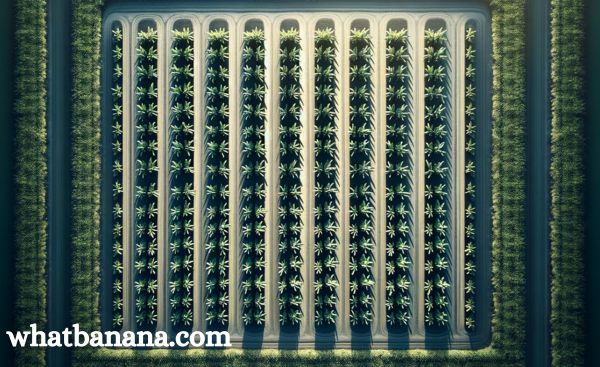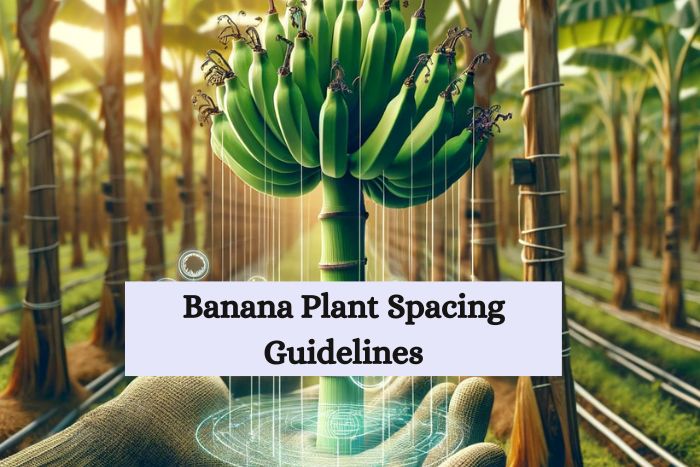Understanding the Importance of Proper Banana Plant Spacing
Banana cultivation is a fascinating and potentially profitable venture, but it requires careful planning and knowledge, especially when it comes to plant spacing.
Proper spacing is crucial for the healthy growth of banana plants and for achieving optimal yields.
This comprehensive guide will delve into the essentials of banana plant spacing guidelines, drawing from expert sources and proven agricultural practices.
Banana Plant Spacing: The Game-Changer for Your Garden!
Banana plant spacing is crucial for optimal growth and yield, requiring at least 12 feet of space for most varieties and 8 feet for dwarf types. Proper spacing ensures adequate sunlight, and air circulation, and facilitates effective plantation management, including support systems and inter-cropping.
Why is Proper Spacing Important?
Spacing banana plants correctly is vital for several reasons.
It ensures adequate sunlight and air circulation, which are essential for healthy growth.
Overcrowded plants can lead to stunted growth, smaller fruit bunches, and increased susceptibility to diseases and pests.
Proper spacing also facilitates easier access for maintenance, harvesting, and allows for efficient use of land.
🍌 Banana Plant Growth Stages 🌱 |
|
|---|---|
| Germination | 2-3 weeks after planting |
| Leaf Development | 5-7 weeks, first leaves emerge |
| Rapid Growth Phase | 2-6 months, rapid increase in height |
| Flowering | 6-8 months, flower emerges |
| Fruit Development | 8-10 months, bananas develop |
| Harvest | 9-12 months, bananas ready for harvest |
| Brought to You by whatbanana.com | |
General Spacing Guidelines
The spacing for banana plants varies depending on the variety and the cultivation method.
Most banana varieties require at least 12 feet of space in each direction.
This spacing allows the plants’ root mats to expand and supports additional stem growth.
For dwarf varieties, a closer spacing of about 8 feet is often sufficient.
In commercial plantations, a common spacing pattern is 11 by 11 feet or 8 by 12 feet, balancing the need for equipment access and maximizing production.
Crucial Guidelines for Optimal Banana Plant Spacing
Different banana varieties have unique spacing requirements.
For instance, taller varieties might need more space compared to dwarf or semi-dwarf types.
The spacing can also depend on the plant’s growth habit and the size of its root system.
It’s essential to research the specific spacing needs of the variety you plan to grow.
Planting Patterns
In countries like the Philippines, two common planting patterns are used: square and triangular.
Square planting is simpler and allows for intercropping, while triangular planting, which requires fewer trees per hectare, is more suitable for tissue culture banana suckers.
The choice of pattern can significantly impact the plantation’s overall productivity and ease of management.

Soil and Environmental Considerations
The choice of planting site is as important as the spacing itself.
Bananas thrive in warm spots with fertile, well-drained soil.
Avoid planting in exposed areas prone to high winds.
If planting near a wall or fence, ensure there’s enough room for root growth – at least 10 feet clearance is recommended.
Maximizing Yield and Health With Effective Banana Plant Spacing
Once the banana mat is established, it’s crucial to manage the number of plants within it.
This involves removing all but the main trunk and a few additional stems of various sizes.
Controlling the plant density within the mat ensures sufficient nutrition for each plant and avoids overcrowding, which can lead to reduced fruit quality and increased disease transmission.

Support Systems and Propping
Banana plants, especially when bearing heavy fruit loads or in windy conditions, may require support.
Propping with wooden stakes or bamboo can prevent plants from leaning or falling.
Overhead and ground guying are two common propping techniques used to provide additional support to the plants.
Inter-Cropping and Companion Planting
When planning banana plant spacing, consider the possibility of inter-cropping.
Certain crops can be grown between banana rows, optimizing land use and potentially improving soil health.
However, it’s important to choose companion plants that won’t compete aggressively with the bananas for nutrients and sunlight.
How to Grow a Banana Plant
Final Thoughts
- Proper spacing of banana plants, typically 12 feet for standard and 8 feet for dwarf varieties, is essential for healthy growth and maximum yield, similar to how trees in a well-maintained orchard are spaced for optimal sunlight and air circulation.
- Adequate spacing reduces the risk of diseases and pests, akin to how crowded urban areas can lead to increased health issues compared to more spacious rural settings.
- Spacing facilitates easier farm management, including maintenance and harvesting, much like how well-organized garden layouts allow for more efficient care and better produce.
- Implementing support systems for banana plants, especially in windy conditions, is comparable to using scaffolding in construction for stability and safety.
- Considering inter-cropping with banana plants can optimize land use and improve soil health, similar to how companion planting in a home garden enhances plant growth and soil quality.
Adhering to proper banana plant spacing guidelines is a critical component of successful banana cultivation.
It not only promotes healthy plant growth and maximizes yield but also helps in efficient farm management.
Whether you’re a small-scale grower or a commercial farmer, understanding and implementing these guidelines can lead to a thriving banana plantation.
And would you believe you can grow bananas in colder climates, too?
FAQ
- What is the ideal spacing for planting banana trees?
- The ideal spacing for most banana varieties is about 12 feet in each direction, while dwarf varieties can be spaced closer, around 8 feet apart. This spacing ensures adequate sunlight, air circulation, and room for growth.
- Can different banana varieties be planted together, and how does this affect spacing?
- Different banana varieties can be planted together, but it’s important to consider their individual spacing needs. Taller varieties might require more space compared to dwarf or semi-dwarf types, so spacing should be adjusted accordingly.
- How does proper spacing of banana plants impact their health and yield?
- Proper spacing reduces competition for nutrients, water, and sunlight, leading to healthier plants. It also improves air circulation, which reduces the risk of diseases and pests, ultimately contributing to a higher yield.
- Is it necessary to adjust spacing for banana plants in different climates?
- While the basic spacing guidelines generally apply, adjustments might be needed based on specific climate conditions. For instance, in windier climates, more space might be beneficial to reduce the risk of plants toppling over.
